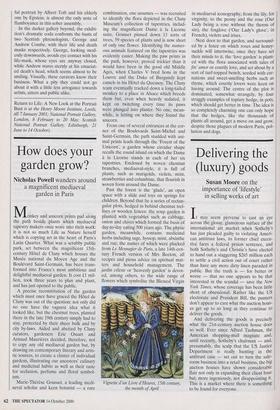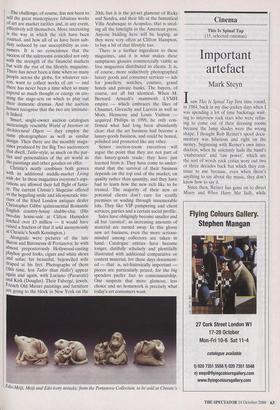Delivering the (luxury) goods
Susan Moore on the importance of 'lifestyle' in selling works of art It may seem perverse to cast an eye across the glossy, glamorous surface of the international art market when Sotheby's has just pleaded guilty to violating Ameri- can antitrust laws, its former chief execu- tive faces a federal prison sentence, and both Sotheby's and Christie's have elected to hand out a staggering $265 million each to settle a civil action out of court rather than have any more dirty linen paraded in public. But the truth is — for better or worse — that no one appears to be that interested in the scandal — save the New York Times, whose coverage has been little short of obsessional. Rather like the US electorate and President Bill, the punters don't appear to care what the auction hous- es get up to so long as they continue to deliver the goods.
And delivering the goods is precisely what the 21st-century auction house does so well. Ever since Alfred Taubman, the American shopping-mall magnate and, until recently, Sotheby's chairman — and, presumably, the scalp that the US Justice Department is really hunting in the antitrust case — set out to turn the sale- room business into a retail business, the big auction houses have shown considerable flair not only in expanding their client base but, more ingeniously, not disappointing it. This is a market where there is something to be found for everyone.
The challenge, of course, has not been to sell the great masterpieces: fabulous works of art are market rarities and, in any event, effectively sell themselves. More interesting is the way in which the rich have been courted, and how all of us have been sub- tlety seduced by our susceptibility as con- sumers. It is no coincidence that the success of the salerooms coincided not only with the strength of the financial markets but with the rise of the lifestyle magazine. There has never been a time when so many people across the globe, for whatever rea- son, want to collect works of art — and there has never been a time when so many expend so much thought or energy on cre- ating the stage-sets on which to play out their domestic dramas. And the auction houses recognise that the two are intimate- ly linked.
Smart, single-owner auction catalogues Increasingly resemble World of Interiors or Architectural Digest — they employ the same photographers as well as similar design. Then there are the monthly maga- zines produced by the Big Two auctioneers that dwell, Tatler-style, as much on the par- ties and personalities of the art world as the paintings and other goodies on offer. Christie's neatly combines both genres with its additional middle-market Living with Art. In these magazines everyone's aspi- rations are allowed their full flight of fanta- sY. The current Christie's Magazine offered us the beguiling smile and idiosyncratic inte- riors of the feted London antiques dealer Christopher Gibbs: quintessential Romantic English country-house shabby-chic. (His two-day house-sale at Clifton Hampden fetched over £3 million — it would have raised a fraction of that if sold anonymously at Christie's South Kensington.) Alongside were pictures of the late Baron and Baronessa di Portanova; he with almost preposterously Hollywood-casting playboy good looks, cigars and white shoes and sofas; his beautiful, bejewelled wife draped at his feet. Photographs of them (this time, less Tatler than Hello!) appear again and again, with Luciano (Pavarotti) and Kirk (Douglas). Their Faberge, jewels, French Old Master paintings and furniture are going to the block in New York on the
20th, but it is the jet-set glamour of Ricky and Sandra, and their life at the fantastical Villa Arabesque in Acapulco, that is steal- ing all the limelight in the American press. Anyone bidding here will be hoping, as they were very often at Clifton Hampton, to buy a bit of that lifestyle too.
There is a further ingredient to these magazines, and it is what makes these sumptuous glossies commercially viable as free magazines distributed to clients. It is, of course, more seductively photographed luxury goods and consumer services — ads for jewellery, watches, couture, grand hotels and private banks. The buyers, of course, are all but identical. When M. Bernard Arnault's mammoth LVMH empire — which embraces the likes of Chaumet, Givenchy and Lacroix as well as Most, Hennessy and Louis Vuitton acquired Phillips in 1999, he only con- firmed what had long been abundantly clear: that the art business had become a luxury-goods business, and could be honed, pOlished and promoted like any other.
Senior auction-room executives will argue the point that they are not part of this luxury-goods trade; they have just learned from it. They have come to under- stand that the survival of their business depends on the top end of the market, on quality rather than quantity, and they have had to learn how the new rich like to be treated. The majority of their new or potential clients don't care for scruffy premises or wading through innumerable lots. They like VIP pampering and client services, parties and a certain social profile.
Sales have obligingly become smaller and all but `curated', as increasing amounts of material are turned away. In this glossy new art business, even the more serious- minded among collectors are taken in hand. Catalogue entries have become longer, dutifully scholarly and plentifully illustrated with additional comparative or context material, for these days document- ed — that is, art-historically important pieces are particularly prized, for the big spenders prefer fact to connoisseurship. One suspects that more glamour, less choice and no homework is precisely what today's art consumers want.
Edo-Meiji, Meiji and Edo ivory netsuke, from the Portanova Collection, to be sold at Christie's



















































































 Previous page
Previous page